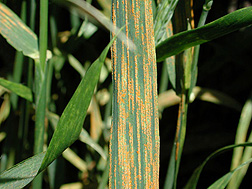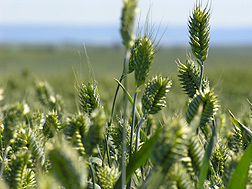New Club Wheat Holding Its Own Against Fungal Disease
|
|
Pacific Northwest wheat growers now have added insurance against outbreaks of yield-robbing fungi, thanks to Cara, a soft, white, winter club wheat cultivar developed by the Agricultural Research Service that boasts high levels of disease resistance and outstanding flour quality.
Washington State accounts for 77 percent, or 230,000 acres, of the entire U.S. club wheat crop, with the remainder produced in Oregon and Idaho. Much of the acreage in Washington and Oregon is planted with three cultivars: Bruehl, Cara, and Chukar. Spring-sown club wheat cultivars JD and Eden are grown on another 11,000 acres. Although several other winter club wheats are available, there’s been a push to broaden the specialty crop’s genetic diversity, especially amid the latest fungal disease flareup.
“Recently, we’ve had severe epidemics of stripe rust, which is able to mutate rapidly and overcome the resistance that’s present in the current crop,” says Kim Garland-Campbell, an ARS geneticist who coordinates the club wheat breeding program. “We’re correcting former deficiencies, like poor disease resistance, in today’s club wheat and put together a crop production package that’s better than what was available.”
Cara, the program’s latest offering, combined high grain yields and flour quality with resistance to multiple fungal diseases, most notably stripe rust, which has inflicted yield losses of up to 40 percent. The release and subsequent sale of Cara, in 2009, “coincided with a stripe-rust epidemic and has driven a lot of the popularity,” notes Garland-Campbell, with the ARS Wheat Genetics, Quality, Physiology, and Disease Research Unit in Pullman, Washington.
|
|
In Washington, Cara was planted on 17,900 acres in 2011, primarily in the Palouse, a fertile agricultural region encompassing part of southeastern Washington and north-central Idaho. Growers in Oregon and Idaho planted 1,500 and 1,000 acres, respectively, of the cultivar.
Like that from other club wheats, flour milled from Cara has low viscosity and protein content, coupled with high “break flour” and “weak gluten”—characteristics ideal for making air-leavened cakes, sugar snap cookies, biscuits, pastries, and other soft, fluffy-textured baked goods. Weakened gluten is important because it means “you can whip the batter up to give it height, whereas with a regular flour, this would give it a tough consistency,” explains Garland-Campbell. “Break flour is associated with softness and gives the flour its fine texture.”
Club wheat flour is mainly exported to Pacific Rim countries, including Japan, Taiwan, and Korea, and is considered a value-added component of the market-class blend known as “western white wheat.” For example, in Japan, this high-quality blend of soft white and 10-20 percent club wheat commands a premium price and is the flour of choice for making Kasutera, a traditional Japanese sponge cake.
In the field, however, Cara is one tough cookie. It contains genes (Yr17, Pch1, and others) that enable it to withstand attack by the stripe rust fungus, Puccina striiformis; Oculimacula yallundae, which causes straw breaker foot rot; and Blumeria graminis, the culprit behind powdery mildew.
Though fungicides have proven effective against these pathogens, “We’ve found that you still need some level of resistance in the crop, because you can’t always get the fungicide on the crop in time—especially with fall infections—and fungicides are an added cost to production,” says Garland-Campbell.
|
|
Based on 60 yield trials conducted in plots where stripe rust was present in Oregon and Washington, Cara outperformed most other commercial cultivars, with 2-year yield averages ranging from 3 to 18 percent better than other cultivars in the trials. Cara’s best performance was in five environments in the 16- to 20-inch rainfall zone of the 2011 Washington cereal variety-testing trials. Yields averaged 157 bushels per acre on rain-fed wheat production, surpassing those of top-performing commercial club wheat checks Bruehl, Chukar, and Coda, as well as soft white wheat checks Brundage96, ORCF102, and Xerpha—especially in areas with severe rust.
Cara—which was derived from crossing three diverse germplasm sources—is primarily adapted to the Palouse and other rust-prone areas with 15-24 inches of annual precipitation. It grows as a semi-dwarf plant and has sturdy stems that are less prone to lodging, or toppling over such that its grain can’t be harvested.
Cara’s milling, baking, and end-use properties were evaluated using international protocols set forth by AACC International (formerly American Association of Cereal Chemists). In those evaluations, Cara proved “as good as the best club wheat check cultivars with high break flour and cake volumes,” Garland-Campbell and coauthors report in an upcoming issue of Crop Science. The milling quality is especially good, says Garland-Campbell. “We like to call it a monster miller.”
In addition to colleagues in the ARS laboratory and at Washington State University in Pullman, Garland-Campbell collaborated on Cara’s development, testing, and release with scientists at the University of Minnesota, Purdue University, Oregon State University, and Connell Grain Growers, Inc., of Connell, Washington.
The researchers are now focusing on improving other desirable traits, including winterhardiness and grain volume. They have two new club wheat cultivars, ARS-Crescent and ARS-Chrystal, on seed increase, making the Pacific Northwest’s club wheat crop even more of an asset to growers eyeing lucrative markets abroad.—By Jan Suszkiw, Agricultural Research Service Information Staff.
This research is part of Plant Genetic Resources, Genomics, and Genetic Improvement, an ARS national program (#301) described at www.nps.ars.usda.gov.
Kim Garland-Campbell is in the USDA-ARS Wheat Genetics, Quality, Physiology, and Disease Research Unit, Washington State University, Room 209, Johnson Hall, Pullman, WA 99164; (509) 335-0582.
"New Club Wheat Holding Its Own Against Fungal Disease" was published in the February 2013 issue of Agricultural Research magazine.









